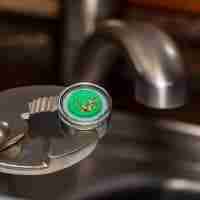How to remove faucet aerator. One of the problems with faucet aerators is that they get clogged up with all sorts of gunk, leading to water pressure issues.
This is more common in regions where your water supply has high mineral content. Many householders aren’t even aware that this fitting exists, so they are on call for a plumber – sigh!
You need to turn off the water to inspect safe conditions. Then look inside to see if it’s clogged or if the actual unit needs to be replaced.
How To Remove Faucet Aerator
We will discuss here the methods of removing the faucet.
Method 1: Remove by Hand
Before you begin, drape a towel over the sink and thoroughly dry the faucet and your hands. Remove any washers below your ideal water temperature if you have one (refer to pictures on page 13).
Apply third gear with a wrench or channel-lock pliers to the looped end of the tool. Remember that spinning tools at high speeds may not be sufficient to release stubborn layers of paint build-up. This trick is great because it doesn’t require any tools!
Method 2: Use Pilers
If you’ve tried and failed to unscrew a faucet aerator with your hands, try using pliers. Wrap a rag or masking tape around the faucet aerator to protect the metal surface from scratches before gripping it with the pliers if it is in good condition and can be reused.
This is best done with a small set of channel-type pliers. Grip the aerator between the pliers’ jaws, ensuring that the jaws are only on the aerator and not on any part of the spout. Unscrew it from your faucet spout by turning it counter-clockwise.
Method 3: Heat the Aerator
The aerator could be stuck because of wear if your faucet is old. Take it off with a pair of pliers. If you can’t loosen it, try applying gentle heat using a hairdryer, which may slightly expand the metal and make it possible to reduce it with pliers.
Don’t do this for too long, though, as the aerator could melt any plastic parts or rubber washers if the faucet is overheated.
You should also check if the water pressure has dropped recently—if so, that could mean you need to replace your faucet aerator anyway!
Method 4: Apply Penetrating Oil
Penetrating oil (such as WD-40 or a similar substance) may loosen frozen aerators if you’ve tried everything else. So spray the area and wait a few minutes before attempting to spread it again.
Wipe away any excess oil from the spout’s interior, as it could make the metal too slippery to unscrew with screwdrivers otherwise.
Avoid lubricating or motor oils because they are too thick and heavy to flow into small crevices and help free up frozen aerators.
FAQs
Do all faucet aerators unscrew?
Most faucet aerators have been threaded on by hand, and often you can unscrew them the same way. To remove it the best way, you need to ensure that your hands are dry so as not to break a sweat and let you get a good grip which is essential when trying to unscrew anything.
Is there a tool to remove a faucet aerator?
The new multi-use aerator key from Danco will allow you to rest assured, knowing that your faucet is always operating at the correct flow rate.
Over time, aerators can get clogged with mineral deposits which may slow water flow or, in some instances, eliminate water flow.
Either way, you’ve got a problem on your hand and need to install a new aerator before any further damage is done.
Conclusion
The easiest way to avoid a hassle is to take care of minor yet persistent problems before they have a significant chance of getting only bigger. While removing an aerator from your faucet may not be the biggest problem out there, it can be a challenge for someone who doesn’t have much experience working with lawn and garden maintenance tools, so we wanted to offer you some tips that might help you deal with it.
Related Guides



